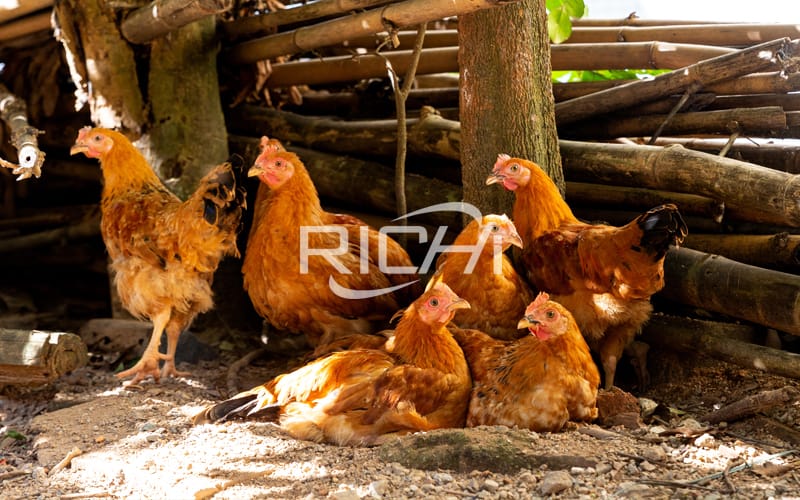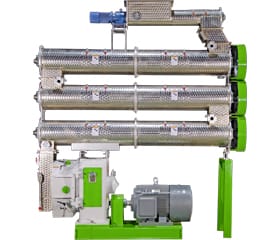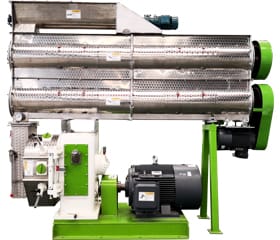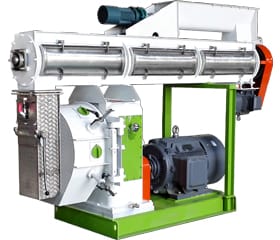The management measures of the air environment in the chicken house

1. Brooding temperature
(1) Temperature difference brooding method
The brooding umbrella is used as the heat source in the brooding area for brooding. In the first three days, keep 35°C under the brooding umbrella. At this time, the edge of the brooding umbrella is about 30~31°C, while other areas of the brooding house only need 25~27°C. In this way, the chicks can go in and out under different temperature layers according to their own needs, which is beneficial to stimulate the growth of their feathers. After the temperature is removed, the chicks will be strong and well-raised in the future. As the chicks grow up, the temperature at the edge of the brooding umbrella should drop by about 1°C every 3-4 days. After three weeks of age, it will basically drop to the same temperature (22~23°C) in other areas of the brooding house. After that, you can stop using the brooding umbrella.
The behavior and chirping of the chicks will indicate how comfortable the chicks are. The chicks are too noisy during the brooding period, indicating that the birds are uncomfortable. The most common reason is that the temperature is not suitable. When the chicks are under cold stress, they will pile up under the brooding umbrella; if the temperature under the brooding umbrella is too low, the chicks will pile up on the wall or around the pillars of the chicken house. The chicks will squeeze in the feed pan. When chicks are under heat stress, they will lie on their stomachs and stretch their heads and necks to pant. The chicks will seek cooler places in the house with high winds, especially away from heat sources along the walls. The chicks will crowd around the drinker, soaking their bodies. Drinking water will increase. The crop and intestines will swell due to excess water.
(2) Whole house heating and brooding method
Different from the temperature difference brooding method (also called the local heating brooding method), the whole house heating brooding method uses a boiler as a heat source, and heat is provided by a radiator (or hot air blower) in the house; or a hot blast stove is used as a heat source for heating. Therefore, the whole house heating method is also called central heating method. Since the brooding umbrella is not used, there is no obvious temperature difference in different areas of the chicken house, so it is a bit difficult to use the behavior of the chicks to indicate the temperature. In this way, the chick's cry becomes the only indicator of the discomfort of the chick.
As long as the opportunity is given, the chicks are willing to gather where the temperature best suits their needs. Be especially careful when observing the behavior of the chicks. The chicks may be concentrated in a certain place in the chicken house, showing the phenomenon of clustering, but don’t think that this is because the temperature in the chicken house is too low. Sometimes, this may also be because other parts of the chicken house are too hot. . Generally speaking, if the chicks are evenly dispersed, it indicates that the temperature is ideal.
When the whole house is used to warm the brood, the temperature of the chick height in the brooding area should be kept between 29 and 31 ℃ for the first three days. The thermometer (or sensor) should be placed 6 to 8 cm away from the ground, so that it can truly reflect the true temperature that the chicks can feel. In the future, as the chicks grow up, the temperature at the height of the chicks should drop by about 1°C every 3 to 4 days, until they are basically 21-22°C after three weeks of age.
2. Relative humidity
When the entire chick house is heated, especially when using nipple drinkers at the same time, the relative humidity may be as low as 25%. Of course, in most chicken houses that use traditional gas brooders combined with bell drinkers, the relative humidity is relatively high, usually exceeding 50%. In order to reduce the degree of dehydration of chicks, the relative humidity of the first 3 to 4 days of age should be at least 70%, preferably 80%. After that, the relative humidity is allowed to be between 50% and 60%.
If the chicken house is equipped with a sprayer that cools down during the high temperature in summer, it can increase the relative humidity of the brooding house to the required range. If there is no sprayer, placing a water pan near the heater can also increase the relative humidity to between 70% and 80%. You can also spray water regularly on the aisles in the middle of the chicken coop to increase the humidity in the chicken coop (note: do not directly spray water on the brooding litter or sprinkle water on the chickens). Chicks are not easily dehydrated under conditions of appropriate relative humidity, and can provide a good start for improving uniformity.
As the brooder grows, the relative humidity should decrease. After 18 days of age, if the relative humidity is too high, it will cause the litter to be wet and cause other problems. As the brooder's weight increases, ventilation and heating systems can be used to control the relative humidity.
3. Interaction of temperature and humidity
All animals evaporate water through the digestive tract and skin, and radiate body heat. In the case of high humidity, the amount of evaporation decreases, which leads to an increase in the animal's body surface temperature. The animal's perception of temperature comes from the dry bulb temperature and relative humidity. Too high relative humidity increases the body surface temperature. Conversely, low relative humidity will lower the body surface temperature. The dry bulb temperature required to reach the standard temperature under different relative humidity should be mastered, and it should be used in environments with different humidity ranges.
If the relative humidity is not within the standard range, the temperature of the chicks in the house should reach the corresponding standard. At all times, it should be observed whether the chicks' behaviors reflect the temperature normally to ensure that the brooding chicks get the right temperature. If subsequent behavior indicates that the chicks are too cold or too hot, the temperature of the house should be controlled within an appropriate range.
4. Ventilation management
During the brooding period, although the chicks do not need too much ventilation, they also need to properly supplement oxygen, remove moisture, ammonia, carbon dioxide and other toxic and harmful gases. Therefore, the brooding house should be properly ventilated regularly and fresh air should be introduced while keeping heat preservation.
You can directly consult Richi Machinery for more questions about"China supplier fully automatic 10t/h chicken feed pellet production machine line for poultry feed""China supplier small 1 ton per hour poultry chicken feed pellet making plant with CE""Widely used wholesale customized 5 ton per hour poultry animal feed processing plant for sale""Chinese professional manufacturer animal feed making machines",Email: enquiry@richi-machine.com,Whatsapp/Cel: +86 185 7410 3366
If you want to built one complete pellet production line in your country, pls send the inquiry to us. We will customized design according to your requirement.



